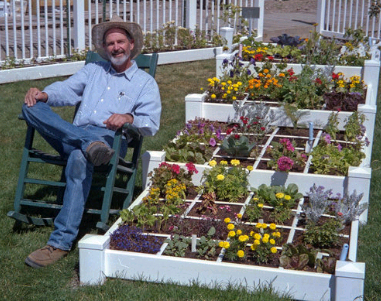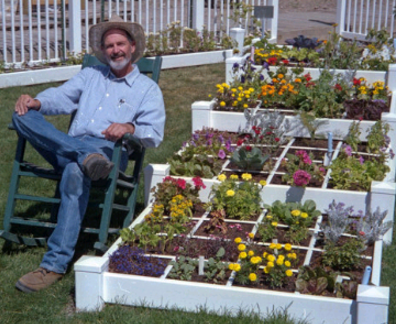What is square foot gardening? A simple, unique and versatile system that adapts to all levels of experience, physical ability, and geographical location. Grow all you want and need in only 20% of the space of a conventional row garden. Save time, water, work and money! I am following the square foot gardening method, and I'll be using it as a reference through out the blog. Square foot gardening invented by the genius Mel Bartholomew! Learn more about it in his website , Or order his very very valuable book. It may come in downloadable PDF files too, if you search. 
Here are the 10 things that make SFG different from traditional row gardening:
- Layout. Arrange your garden in squares, not rows. Lay it out in 4′x4′ planting areas. Companion plants can help each other grow bigger and tastier!
- Boxes. Build boxes to hold a new soil mix above ground. Your existing soil doesn't matter! forget about it, and just worry about the new soil called Mel's Mix.
- Aisles. Space boxes 3′ apart to form walking aisles. It makes it easier to walk and sit around the boxes, especially when your plants get really big and spill out of the boxes a little.
- Soil. Fill boxes with Mel’s special soil mix: 1/3 blended compost (please please make your own! The compost sold in Kuwait is a little shady) , 1/3 peat moss, and 1/3 coarse vermiculite (All available in True Value).
- Grid. Make a permanent square foot grid for the top of each box. A MUST!
- Care. NEVER WALK ON YOUR GROWING SOIL. This is how the soil stays so fluffy and airy for the roots stay happy. Tend your garden from the aisles.
- Select. Plant a different flower, vegetable, or herb crop in each square foot, using 1, 4, 9, or 16 plants per square foot. You might, for example, plant a single tomato in a square, but you’d plant 16 carrots in another. Using this system, you can cram a lot of garden into a small space and still get excellent yields.
- Plant. Conserve seeds. Plant only a pinch (2 or 3 seeds) per hole. Place transplants in a slight saucer-shaped depression. This means you wont waste seeds! The traditional way is to plant lots of seeds then cut off the majority and leave the strongest.
- Water. Water by hand from a bucket of sun-warmed water.
- Harvest. When you finish harvesting a square foot, add only compost and replant it with a new and different crop.
 I decided how big of an area I want to use, I am placing my SFG on the roof of my house, which I made sure received at least 8 hours of full sun. I am going big and starting with lots of boxes. So after thorough planning I decided I want two 4x4 square foot boxes (which is the standard) two smaller boxes for root vegetables like carrots and potatoes, and one long box for herbs. You can download the guide I created for the carpenters here . Its not the most accurate illustration of what the boxes look like in the end, but the numbers are right.
I decided how big of an area I want to use, I am placing my SFG on the roof of my house, which I made sure received at least 8 hours of full sun. I am going big and starting with lots of boxes. So after thorough planning I decided I want two 4x4 square foot boxes (which is the standard) two smaller boxes for root vegetables like carrots and potatoes, and one long box for herbs. You can download the guide I created for the carpenters here . Its not the most accurate illustration of what the boxes look like in the end, but the numbers are right. You can change the measurements how ever you like, most importantly, you have to make sure each square is 1ft squared in size= 30 cm. Also Most vegetables require 6 inches of soil, I've decided to use around 20cm. If the boxes are placed over a garden/soil, they don't need bottoms. In my case, I have to apply bottoms since they're going to be in the roof. The bottoms are waterproof 2cm thick plywood. The plywood has to have around 0.6 cm holes drilled in each square, plus in the corners. My boxes have weird squares in the plywood because the carpenter mistook 0.6cm for huge 6cm holes, I had them fix them without problems. Potato/Carrot beds:
You can change the measurements how ever you like, most importantly, you have to make sure each square is 1ft squared in size= 30 cm. Also Most vegetables require 6 inches of soil, I've decided to use around 20cm. If the boxes are placed over a garden/soil, they don't need bottoms. In my case, I have to apply bottoms since they're going to be in the roof. The bottoms are waterproof 2cm thick plywood. The plywood has to have around 0.6 cm holes drilled in each square, plus in the corners. My boxes have weird squares in the plywood because the carpenter mistook 0.6cm for huge 6cm holes, I had them fix them without problems. Potato/Carrot beds:  One of the 4x4' beds with the herb bed:
One of the 4x4' beds with the herb bed:  You can of course build your own boxes, and a very detailed guide is in the book. Im sure its much more fun.I don't have the skill or time, so I had the boxes done for 50KD total, 30 for the wood and 20 for the building. The work was done by Ibrahim in Classic Design Carpentry :
You can of course build your own boxes, and a very detailed guide is in the book. Im sure its much more fun.I don't have the skill or time, so I had the boxes done for 50KD total, 30 for the wood and 20 for the building. The work was done by Ibrahim in Classic Design Carpentry :  Don't forget, you can collect sawdust for free and use it as a carbon source in your compost! Maybe I'll paint the outsides of the boxes with the kids before the season starts, what do you think?
Don't forget, you can collect sawdust for free and use it as a carbon source in your compost! Maybe I'll paint the outsides of the boxes with the kids before the season starts, what do you think?


25001 comments
‘Extraordinary rainstorm’ floods Nebraska city, triggers water rescues
[url=https://tripscan.biz]tripscan top[/url]
An entire June’s worth of rain fell in just a few hours over Grand Island, Nebraska, Wednesday night, triggering life-threatening flash flooding that inundated neighborhoods, stranded motorists and forced water rescues.
Crews have responded to dozens of calls to assist motorists stuck in flooded roads since torrential rain began Wednesday night, according to Spencer Schubert, the city’s communications manager. The flooding has also displaced an unspecified number of residents from their homes.
https://tripscan.biz
tripscan top
“At this time we have no injuries to report,” Schubert said early Thursday morning, noting some rescues were ongoing.
Torrential rain caused sewers to back up into several homes and sent floodwater running into basements, according to a Thursday news release from the city. Some affected residents took shelter at local hotels or with friends and family.
“This was an extraordinary rainstorm and is very similar to the historic rains seen in the 2005 floods,” Jon Rosenlund, the city’s emergency director said. “We will be actively monitoring rivers, creeks and other drainage areas over the next few days for future flooding issues.”
Flooding in 2005 turned streets into rivers in Grand Island. At one point, the city tore up a major road to open up a channel to drain flooding away from homes, CNN affiliate KHGI reported.
The central Nebraskan city is home to around 53,000 people and is about 130 miles southwest of Omaha. The rain came to an end around sunrise Thursday, but the danger remains, with a flood warning in effect until 7 p.m. CDT.
“Generally, if people were more informed about the average
[url=https://tripscan.biz]tripscan[/url]
(environmental) cost of generating a response, people would maybe start thinking, ‘Is it really necessary to turn myself into an action figure just because I’m bored?’ Or ‘do I have to tell ChatGPT jokes because I have nothing to do?’” Dauner said.
Additionally, as more companies push to add generative AI tools to their systems, people may not have much choice how or when they use the technology, Luccioni said.
“We don’t need generative AI in web search. Nobody asked for AI chatbots in (messaging apps) or on social media,” Luccioni said. “This race to stuff them into every single existing technology is truly infuriating, since it comes with real consequences to our planet.”
https://tripscan.biz
tripscan top
With less available information about AI’s resource usage, consumers have less choice, Ren said, adding that regulatory pressures for more transparency are unlikely to the United States anytime soon. Instead, the best hope for more energy-efficient AI may lie in the cost efficacy of using less energy.
“Overall, I’m still positive about (the future). There are many software engineers working hard to improve resource efficiency,” Ren said. “Other industries consume a lot of energy too, but it’s not a reason to suggest AI’s environmental impact is not a problem. We should definitely pay attention.”
Sign up for CNN’s Life, But Greener newsletter. Our limited newsletter series guides you on how to minimize your personal role in the climate crisis — and reduce your eco-anxiety.
посмотреть на этом сайте [url=https://t.me/mounjaro_tirzepatide]оземпик 0.25 купить[/url]
https://kazan.smidas.ru/
https://ufa.smidas.ru/